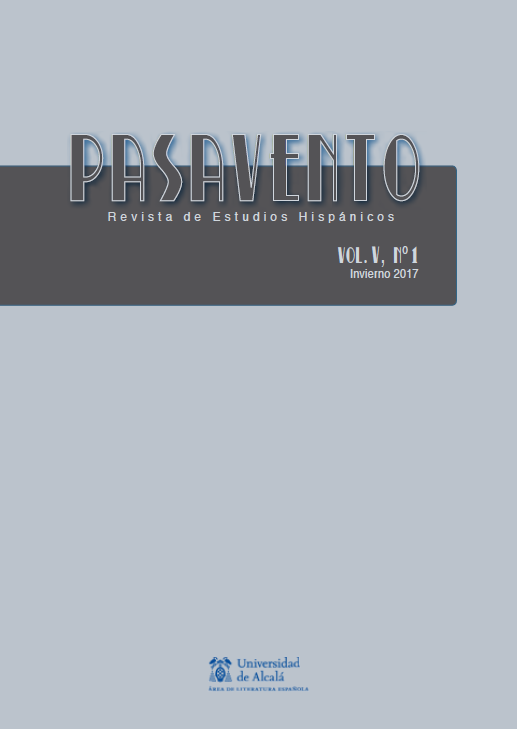Creating Meaning on the Threshold between Media. Mario Bellatin’s “Texto-Foto-Amalgama” Format
DOI:
https://doi.org/10.37536/preh.2017.5.1.865Keywords:
Mario Bellatin, Literature and Photography, Intermediality, PhotolegendAbstract
This article analyses the relationship between text and photo –which Mario Bellatin calls the texto-foto-amalgama-format– in the light of the intermedial cyclus that was published between 2008 and 2009 and that includes the following titles: “Todos saben que el arroz que cocinamos está muerto. Pequeña autobiografía ilustrada”, Biografía ilustrada de Mishima, Las dos Fridas, Los fantasmas del masajista, and El libro uruguayo de los muertos (2012). Amid the substantial interconnections of these publications, this article reflects the migration and reuse of the photographic material. Applying intermediality theories, we analyse how meaning, experience and literary perceptions are constructed and changed. The first part of this article examines the texto-foto-amalgama-format, and the second focuses on the migrations.
References
Bellatin, Mario (2002): Shiki Nagaoka: una nariz de ficción. Lima, PUCP / Fondo Editorial.
Bellatin, Mario (2003): Perros héroes: tratado sobre el futuro de América Latina visto a través de un hombre inmóvil y sus treinta Pastor Belga Malinois. México D.F., Aguilar.
Bellatin, Mario (2006): Jacobo el mutante. Ed. Ximena Berecochea. Buenos Aires, Interzona.
Bellatin, Mario (2007-2008): “Una cabeza picoteada por los pájaros”. En: Otra Parte. Accesible en <http://www.revistaotraparte.com/n%C2%BA-13-verano-2007-2008/una-cabezapicoteada-por-los-p%C3%A1jaros> [última visita: 27.01.2015].
Bellatin, Mario (2008a): Demerol: sin fecha de caducidad. México, RM.
Bellatin, Mario (2008b): Las dos Fridas. México, Consejo nacional para la cultura y las artes / Lumen.
Bellatin, Mario (2008c): “Todos saben que el arroz que cocinamos está muerto. Pequeña autobiografía ilustrada”, Letras Libres, agosto.
Bellatin, Mario (2009a): Biografía ilustrada de Mishima. Buenos Aires, Entropía.
Bellatin, Mario (2009b): Los fantasmas del masajista. Buenos Aires, Eterna Cadencia.
Bellatin, Mario (2011): La clase muerta: dos textos. México D.F., Alfaguara.
Bellatin, Mario (2012a): El libro uruguayo de los muertos: pequeña muestra del vicio en el que caigo todos los días. Madrid, Sexto Piso.
Bellatin, Mario (2012b): Libro-fantasma de El libro uruguayo de los muertos. Madrid, Sexto Piso.
Bellatin, Mario (2013): Obra reunida. Madrid, Alfaguara.
Bellatin, Mario, y Link, Daniel (2008): “La Nación no gana para sustos”, Linkillo (cosas mías), 13 de abril. Accesible en <http://linkillo.blogspot.fr/2008/04/la-nacin-no-ganapara-sustos.html> [última visita: 02.07.2015].
Böhn, Andreas (ed.) (2003): Formzitat und Intermedialität. St. Ingbert, Röhrig Universitätsverlag.
Camenen, Gersende (2013): “Les étranges texte-images de Mario Bellatin - Fiction biographique et photographie”. En: P. Edwards, V. Lavoie y J.-P. Montier (eds.), Photolittérature, littératie visuelle et nouvelles textualités, http://phlit.org/press/?p=1995 [última visita: 10.02.2015].
Carrillo Martín, Francisco (2010): “La literatura como performance: Mario Bellatin y Severo Sarduy”, Hispamérica, vol. 39, n.° 115, pp. 37-47. Accesible en <http://www.jstor.org/stable/25789959> [última visita: 09.02.2015].
Cote Botero, Andrea (2014): Mario Bellatin: el giro hacia el procedimiento y la literatura como proyecto. Pennsylvania, University of Pennsylvania.
Courtoisie, Rafael (2002): “Crisis o vigencia de los géneros narrativos: Literatura transgénica, transgenérica, transmediática”. En: Eduardo Becerra (ed.), Desafíos de la ficción. Alicante, Universidad de Alicante / Centro de estudios iberoamericanos Mario Benedetti, pp. 67-76.
Covindassamy, Mandana (2014): W. G. Sebald: cartographie d’une écriture en déplacement. París, PUPS.
Deleuze, Gilles, y Guattari, Felix (2002): Mil Mesetas, capitalismo y esquizofrenia, Valencia, Pre-textos.
Epplin, Craig (2015): “Mario Bellatin: Literature and the Data Imaginary”, Revista de Estudios Hispánicos, t. XLIX, n.º 1, pp. 65-89.
Genette, Gérard (1972): Figures 3. París, Éditions du Seuil.
Mariniello, Silvestra (2009): “Cambiar la tabla de operación. El medium intermedial”, Acta Poetica, vol. 30, n.° 3.
Mitchell, William John Thomas (1986): Iconology: Image, Text, Ideology. Chicago/Londres, University of Chicago Press.
Mitchell, William John Thomas (1994): Picture Theory: Essays on Verbal and Visual Representation. Chicago/Londres, University of Chicago Press.
Morris, Adam (2012): “Micrometanarratives and the Politics of the Possible”, The New Centennial Review, vol. 11, n.º 3, pp. 91-71.
Nünning, Vera, y Nünning, Ansgar (2002): Erzähltheorie transgenerisch, intermedial, interdisziplinär. Trier, WVT Wissenschaftlicher Verlag Trier.
Palaversich, Diana (2003): “Apuntes para una lectura de Mario Bellatin”, Chasqui, vol. 32, n.° 1, pp. 25-38.
Rajewsky, Irina O. (2002): Intermedialität. Tubinga/Basilea, A. Francke.
Salinas Escobar, Iván (2006): “Photo et mot: les possibilités narratives de l’image”, TRANS-. Revue de littérature générale et comparée. Accesible en <http://trans.revues.org/153> [última visita: 03.09.2015].
Schmitter, Gianna (2016): “El formato texto-foto amalgama de Mario Bellatin, o la puesta en escena de umbrales”. En: Pascale Peyraga, Marion Gautreau, Carmen Peña Ardid Sojo y Kepa Gil (eds.), La imagen translúcida en los mundos hispánicos. Villeurbanne, Orbis Tertius.
Speidel, Klaus (2013): “Can a Single Still Picture Tell a Story? Definitions of Narrative and the Alleged Problem of Time with Single Still Pictures”, DIEGESIS, vol. 2, n.° 1. Accesible en https://www.diegesis.uni-wuppertal.de/index.php/diegesis/article/view/128 [última visita: 21.02.2015].
Vergara, Pablo: “El vacío como gesto: representación y crisis del sentido en la obra de Mario Bellatin”. Revista Laboratorio. Accesible en <http://www.revistalaboratorio.cl/2010/05/el-vacio-como-gesto-representacion-y-crisis-del-sentido-en-la-obrade-mario-bellatin/> [última visita: 09.02.2015].
Wolf, Werner (2002): “Das Problem der Narrativität in Literatur, bildender Kunst und Musik: Ein Beitrag zu einer intermedialen Erzähltheorie”. En: Vera Nünning y Ansgar Nünning (eds.), Erzähltheorie transgenerisch, intermedial, interdisziplinär. Trier, WVT Wissenschaftlicher Verlag Trier, pp. 23-104.
Downloads
Published
How to Cite
Issue
Section
License
Copyright (c) 2017 Pasavento. Revista de Estudios Hispánicos

This work is licensed under a Creative Commons Attribution 4.0 International License.








